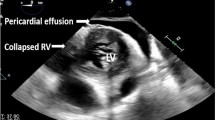Summary.
Peripartum cardiomyopathy (PPCM) is rare cardiac complication afflicting women during pregnancy or until 5 months post partum with the typical signs of acute cardiac failure. PPCM is similar to dilated cardiomyopathy (DCM) in terms of symptoms, histopathology and treatment but is characterized by a better outcome with a high rate of spontaneous normalization of left-ventricular size and function. The understanding of the etiology is limited. However, viral myocarditis and autoimmune factors might be involved in the development of PPCM. Clinically, PPCM shows pulmonary symptoms such as dyspnea, tachypnea and coughing. The diagnosis is finally established by echocardiography. It has to be assumed that PPCM is often undetected or misdiagnosed because of the low incidence, the unspecific symptoms and the fact that other pregnancy-related factors have similar clinical appearance. The treatment is also unspecific and similar to DCM and acute cardiac failure. The severity of the disease requires an interdisciplinary approach in a perinatal center with consequent follow-up of the patients for risk stratification including echocardiography.
Zusammenfassung.
Die peripartale Kardiomyopathie (PPCM) ist eine seltene mütterliche kardiologische Komplikation in der Schwangerschaft bzw. bis 5 Monate post partum und gekennzeichnet durch eine akute Einschränkung der linksventrikulären Pumpfunktion mit typischen Zeichen einer akutenHerzinsuffizienz. Die PPCM entspricht in Klinik, Histomorphologie und Behandlung einer dilatativen Kardiomyopathie (DCM), ist aber gegenüber anderen DCM-Formen durch eine bessere Prognose mit einer hohen Rate einer Normalisierung der linksventrikulären Pumpfunktion charakterisiert. Als mögliche ätiologische Faktoren werden eine virale Myokarditis sowie autoimmunologische Faktoren diskutiert. Klinisch imponiert die PPCM mit einer hauptsächlich pulmonalen Symptomatik mit Dyspnoe, Tachypnoe und Reizhusten. Die Diagnose wird echokardiographisch gesichert. Aufgrund der unspezifischen Symptomatik und der Ähnlichkeit mit anderen physiologischen (z. B. Dyspnoe durch Zwerchfellhochstand) oder pathologischen Schwangerschaftszuständen wird die PPCM mit hoher Wahrscheinlichkeit oft nicht erkannt bzw. fehlgedeutet. Eine spezifische Therapie der PPCM existiert nicht, es gelten die allgemeinen Grundsätze der Therapie der akuten Linksherzinsuffizienz bzw. DCM. Die Behandlung der PPCM erfordert ein enges interdisziplinäres Vorgehen und schließt eine gründliche Nachuntersuchung der Patientinnen mit Echokardiographie zur Prognoseeinschätzung ein.
Similar content being viewed by others
Author information
Authors and Affiliations
Rights and permissions
About this article
Cite this article
Stepan, H., Walther, T. & Pfeiffer, D. Die peripartale Kardiomyopathie—der (un)bekannte geburtshilflich-kardiologische Notfall. Z Kardiol 92, 811–816 (2003). https://doi.org/10.1007/s00392-003-0981-9
Received:
Accepted:
Issue Date:
DOI: https://doi.org/10.1007/s00392-003-0981-9




